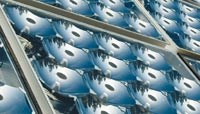Pumping Up Solar Production
Unique finishing process improves CPV manufacturing.
Whether wind or solar, the alternative energy industry is ramping up production. Many such companies lack finishing expertise and are turning to suppliers of finishing equipment and processes for help in bumping up manufacturing productivity.
Case in point: a California-based supplier of concentrated photovoltaic (CPV) systems. The company worked with Turbo Spray Midwest (Howell, MI) to develop a completely new system for finishing and silvering cells for its systems, which employ curved lenses or mirrors to multiply the sun's power up to 600×. Large arrays of such CPV cells can product gigawatts of power at much higher efficiency than flat-panel solar cells.
Turbo Spray, a 25-year-old supplier of finishing processes and systems for automotive and other applications, had expertise in developing coating application processes and specialty low-pressure liquid application heads. Like many other automotive suppliers, the company was looking for new markets. Alternative energy technology presented an opportunity.
In this case, Turbo Spray's task was to move application techniques for protective and reflecting mirror coatings from single-piece to mass production. The company developed a multi-phase plan to improve CPV cell finishing productivity by evolving finishing from a flow-coating operation to spray application.
Turbo Spray's first tasks were to confirm that the coating materials its customer was using, which were formulated for flow coating, were a viable option for mass production. The company then developed spray application processes for the materials.
Next up was development of a method for presenting parts in the spray zone. The curved glass substrate required special attention to avoid breakage and provide accurate part positioning. High cure temperatures added the element of part expansion/contraction, which had to be accounted for in both tooling design and masking.
Phase three of the project centered on how to apply the proper amount of coating over the complete glass substrate. For this, Turbo Spray chose one of its standard guns, an HVLP spray applicator with fluid recirculation through the fluid tube and analog fan and atomizing air control.
Individual gun fluid flow rates, positions and other process parameters had to be developed and tested until the customer's cycle time requirement was achieved. Film thickness for three coats of paint through the cured surface was held to 1 ± 0.2 mils.
Next up was development of a cure cycle for the parts. Turbo Spray determined that electric infrared curing would be most cost-effective, but the concave part shape and customer requirements for no blistering or browning presented challenges. The solution was based on IR fixture style and orientation, plus power ramping in multiple oven zones and part placement inside the oven.
For the final line design, Turbo Spray chose a floor-mounted chain-on-edge system, which could smoothly accelerate, decelerate and stop the fragile parts and withstand heat fluctuations. Other system attributes include:
- Consistent start/stop positions in multiple spray zones
- Consistent coating delivery and temperature
- Consistent and controllable part rotation speeds
- Energy efficiency
- High transfer efficiency using true low-pressure atomizing (8 psi)
- PLC controls with remote operator interface panel
- Small overall machine footprint.
The CPV system supplier has recently installed Turbo Spray's processes for silvering one surface of the mirrors and for applying a protective coating to the other side. Production volumes using the new systems ramped up from one mirror per minute to 5 mirrors per minute. Transfer efficiencies on the difficult part configuration are 80%.
Related Content
Clean Chemistry for Fuel Cell Technology
Leading efforts to improve hydrogen fuel cell efficiency, this Indiana company has developed chemistry that cleans the inorganic contaminants from inside a vehicle’s radiator. This results in cleaner coolant and a more efficiently run hydrogen fuel cell.
Read MorePractical Environmental Management Reduces Costs, Refines Quality
By focusing on effluent treatment and efficient tin recovery, this Indian surface treatment plant meets stringent environmental standards and sustainable high-quality production.
Read MoreNASF/AESF Foundation Research Project #122: Electrochemical Approaches to Treatment of PFAS in Plating Wastewater - 10th Quarterly Report
The NASF-AESF Foundation Research Board selected a project addressing the problem of PFAS and related chemicals in plating wastewater streams. This report covers the 10th quarter of work (April-June 2023). Here, we examine the effect of surface fluorination of Ti4O7 anodes on PFAS degradation performance in terms of energy performance as well as formation of chlorate and perchlorate when chloride is present in the solution. The full paper on this work can be accessed and printed at short.pfonline.com/NASF24Feb2.
Read MoreOnline Energy Savings Calculator Promotes Energy Efficiency
An online energy savings calculator from AkzoNobel aims to help customers determine how to reduce energy usage.
Read MoreRead Next
A ‘Clean’ Agenda Offers Unique Presentations in Chicago
The 2024 Parts Cleaning Conference, co-located with the International Manufacturing Technology Show, includes presentations by several speakers who are new to the conference and topics that have not been covered in past editions of this event.
Read MoreEpisode 45: An Interview with Chandler Mancuso, MacDermid Envio Solutions
Chandler Mancuso, technical director with MacDermid Envio discusses updating your wastewater treatment system and implementing materials recycling solutions to increase efficiencies, control costs and reduce environmental impact.
Read MoreEducation Bringing Cleaning to Machining
Debuting new speakers and cleaning technology content during this half-day workshop co-located with IMTS 2024.
Read More























